Potrebujeme váš súhlas na využitie jednotlivých dát, aby sa vám okrem iného mohli ukazovať informácie týkajúce sa vašich záujmov. Súhlas udelíte kliknutím na tlačidlo „OK“.
ASTM F384-12
Standard Specifications and Test Methods for Metallic Angled Orthopedic Fracture Fixation Devices
Automaticky preložený názov:
Štandardné Špecifikácie a skúšobné metódy pre kovové Uhlová Ortopedická fixácia zlomeniny zariadenia
NORMA vydaná dňa 15.5.2012
Informácie o norme:
Označenie normy: ASTM F384-12
Poznámka: NEPLATNÁ
Dátum vydania normy: 15.5.2012
Kód tovaru: NS-55119
Počet strán: 12
Približná hmotnosť: 36 g (0.08 libier)
Krajina: Americká technická norma
Kategória: Technické normy ASTM
Kategórie - podobné normy:
Anotácia textu normy ASTM F384-12 :
Keywords:
angled devices, bend testing, blade plate, compression hip screw, fatigue test, orthopedic medical devices, surgical devices, surgical implants, ICS Number Code 11.040.40 (Implants for surgery, prothetics and orthotics)
Doplňujúce informácie
| Significance and Use | ||||||||||||||||||||||||||||||||||||||||||||||
|
A2.5.1 The test method establishes a uniform cantilever bending fatigue test to characterize and compare the fatigue performance of different angled device designs. This test method may be used to determine the fatigue life of an angled device at either a specific or over a range of maximum bending moment conditions. Additionally, this test method may be alternatively used to estimate the fatigue strength of an angled device for a specified number of fatigue cycles. A2.5.2 The test method utilizes a simplified angled device cantilever bending load model that may not be exactly representative of the in-situ loading configuration. The user should note that the test results generated by this test method can not be used to directly predict the in-vivo performance of the angled device being tested. The data generated from this test method can be used to conduct relative comparisons of different angled device designs. A2.5.3 This test method may not be appropriate for all types of implant applications. The user is cautioned to consider the appropriateness of the method in view of the devices being tested and their potential application. A2.5.4 This test method assumes that the angled device is manufactured from a material that exhibits linear-elastic material behavior; therefore, this test method is not applicable for testing angled devices made from materials that exhibit nonlinear elastic behavior. A2.5.5 This test method is restricted to the testing of angled devices within the linear-elastic range of the material; therefore, this test method is not applicable for testing angled devices under conditions that would approach or exceed the bending strength of the angled device being tested. |
||||||||||||||||||||||||||||||||||||||||||||||
| 1. Scope | ||||||||||||||||||||||||||||||||||||||||||||||
|
1.1 These specifications and test methods provide a comprehensive reference for angled devices used in the surgical internal fixation of the skeletal system. This standard establishes consistent methods to classify and define the geometric and performance characteristics of angled devices. This standard also presents a catalog of standard specifications that specify material, labeling, and handling requirements, and standard test methods for measuring performance related mechanical characteristics determined to be important to the in vivo performance of angled devices. 1.2 It is not the intention of this standard to define levels of performance or case-specific clinical performance for angled devices, as insufficient knowledge is available to predict the consequences of their use in individual patients for specific activities of daily living. Futhermore, this standard does not describe or specify specific designs for angled devices used in the surgical internal fixation of the skeletal system. 1.3 This standard may not be appropriate for all types of angled devices. The user is cautioned to consider the appropriateness of this standard in view of a particular angled device and its potential application. Note 1—This standard is not intended to address intramedullary hip screw nails or other angled devices without a sideplate. 1.4 This standard includes the following test methods used in determining the following angled device mechanical performance characteristics: 1.4.1 Standard test method for single cycle compression bend testing of metallic angled orthopedic fracture fixation devices (see Annex A1). 1.4.2 Standard test method for determining the bending fatigue properties of metallic angled orthopedic fracture fixation devices (see Annex A2). 1.5 The values stated in SI units are to be regarded as standard. No other units of measurement are included in this standard. Note 2—There is currently no ISO standard that is either similar to equivalent to this standard. |
||||||||||||||||||||||||||||||||||||||||||||||
| 2. Referenced Documents | ||||||||||||||||||||||||||||||||||||||||||||||
|
Podobné normy:
Historická
1.6.2013
Historická
1.3.2014
Historická
1.8.2008
Historická
1.3.2011
Historická
1.4.2014
Historická
1.3.2013
Odporúčame:
Aktualizácia technických noriem
Chcete mať istotu, že používate len platné technické normy?
Ponúkame Vám riešenie, ktoré Vám zaistí mesačný prehľad o aktuálnosti noriem, ktoré používate.
Chcete vedieť viac informácií ? Pozrite sa na túto stránku.


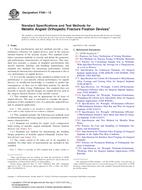
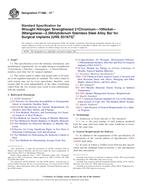 ASTM F1586-13e1
ASTM F1586-13e1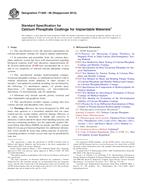 ASTM F1609-08(2014)..
ASTM F1609-08(2014)..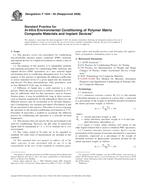 ASTM F1634-95(2008)..
ASTM F1634-95(2008).. ASTM F1635-11
ASTM F1635-11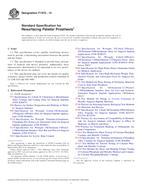 ASTM F1672-14
ASTM F1672-14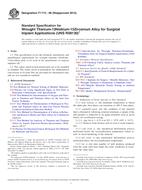 ASTM F1713-08(2013)..
ASTM F1713-08(2013)..
 Cookies
Cookies
